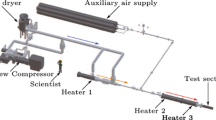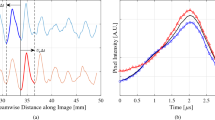Abstract
In this work, an enhanced version of the focused laser differential interferometer (FLDI) is used to measure second-mode instabilities in the boundary layer on a flared cone in Mach 6 quiet flow. A diffractive optical element added to the FLDI system provides six beams that pass through a single Wollaston prism, allowing for multiple points of measurements without the need for additional Wollaston prisms. This technique, linear array-FLDI (LA-FLDI), is used for six simultaneous measurements of second-mode instabilities in a hypersonic boundary layer. This is the first time that this variation of FLDI has been used for second-mode instability measurements and demonstrates that the inclusion of a diffractive optical element into the traditional FLDI and splitting of beam power does not preclude such usage. Thus, LA-FLDI appears to have significant potential for increasing the efficiency of measurements of high-speed boundary layers by enabling multiple measurements at different locations within a single facility run. The velocity of the second-mode wavepacket is estimated and a bispectral analysis is presented showing that harmonics are associated with quadratically phased coupled interactions.
Graphic abstract














Similar content being viewed by others
References
Bathel BF, Weisberger JM, Herring GC, King RA, Jones SB, Kennedy RE, Laurence SJ (2020) Two-point, parallel-beam focused laser differential interferometry with a nomarski prism. Appl Opt 59(2):244–252
Berridge D, Casper K, Rufer S, Alba C, Lewis D, Beresh S, Schneider S (2019) Measurements and computations of second-mode instability waves in several hypersonic wind tunnels. In: 40th Fluid dynamics conference and exhibit (2019). https://doi.org/10.2514/6.2010-5002
Bitter N, Shepherd J (2014) Transient growth in hypersonic boundary layers. In: 7th AIAA theoretical fluid mechanics conference (2014). https://doi.org/10.2514/6.2014-2497
Blanchard AE, Selby GV (1996) An experimental investigation of wall-cooling effects on hypersonic boundary-layer stability in a quiet wind tunnel. Technical report, NASA
Ceruzzi A, Cadou CP (2019) Simultaneous velocity and density gradient measurements using two-point focused laser differential interferometry. In: AIAA Scitech 2019 forum (2019). https://doi.org/10.2514/6.2019-2295
Chen FJ, Wilkinson SP, Beckwith IE (1993) Goertler instability and hypersonic quiet nozzle design. J Spacecr Rockets 30(2):170–175. https://doi.org/10.2514/3.11525
Chokani N (1999) Nonlinear spectral dynamics of hypersonic laminar boundary layer flow. Phys Fluids 11(12):3846–3851. https://doi.org/10.1063/1.870243
Chokani N (2005) Nonlinear evolution of Mack modes in a hypersonic boundary layer. Phys Fluids 17(1):014102. https://doi.org/10.1063/1.1825471
Craig SA, Humble RA, Hofferth JW, Saric WS (2019) Nonlinear behaviour of the Mack mode in a hypersonic boundary layer. J Fluid Mech 872:74–99. https://doi.org/10.1017/jfm.2019.359
Craig SA, Saric WS (2016) Crossflow instability in a hypersonic boundary layer. J Fluid Mech 808:224–244
Demetriades A (1977) Boundary-layer instability observations at Mach number 7. J Appl Mech 44(1):7–10. https://doi.org/10.1115/1.3424019
Fedorov A (2011) Transition and stability of high-speed boundary layers. Annu Rev Fluid Mech 43(1):79–95. https://doi.org/10.1146/annurev-fluid-122109-160750
Fulghum MR (2014) Turbulence measurements in high-speed wind tunnels using focusing laser differential interferometry, Ph.D. Dissertation, Pennsylvania State University. https://etda.libraries.psu.edu/catalog/23596
Gragston M, Price T, Davenport K, Zhang Z, Schmisseur JD (2021) Linear array focused-laser differential interferometry for single-shot multi-point flow disturbance measurements. Opt Lett 46(1):154–157. https://doi.org/10.1364/OL.412495
Gragston M, Price TJ, Davenport K, Schmisseur JD, Zhang Z (2021) An m by n FLDI array for single-shot multipoint disturbance measurements in high-speed flows. In: AIAA Scitech 2021 forum (2021). https://doi.org/10.2514/6.2021-0599
Hameed A, Parziale NJ, Paquin LA, Butler C, Laurence SJ (2020) Hypersonic slender-cone boundary-layer instability in the UMD hyperTERP shock tunnel. In: AIAA Scitech 2020 forum (2020). https://doi.org/10.2514/6.2020-0362
Hofferth J, Bowersox R, Saric W (2010) The Mach 6 quiet tunnel at Texas A&M: quiet flow performance. In: 27th AIAA aerodynamic measurement technology and ground testing conference (2010). https://doi.org/10.2514/6.2010-4794
Hofferth J, Humble R, Floryan D, Saric W (2013) High-bandwidth optical measurements of the second-mode instability in a Mach 6 quiet tunnel. In: 51st AIAA aerospace sciences meeting including the new horizons forum and aerospace exposition (2013). https://doi.org/10.2514/6.2013-378
Jewell JS, Hameed A, Parziale NJ, Gogineni SP (2019) Disturbance speed measurements in a circular jet via double focused laser differential interferometry. In: AIAA Scitech 2019 forum (2019). https://doi.org/10.2514/6.2019-2293
Jewell JS, Parziale NJ, Lam KL, Hagen BJ, Kimmel RL (2016) Disturbance and phase speed measurements for shock tubes and hypersonic boundary-layer instability. In: 32nd AIAA aerodynamic measurement technology and ground testing conference (2016). https://doi.org/10.2514/6.2016-3112
Kendall J (1975) Wind tunnel experiments relating to supersonic and hypersonic boundary-layer transition. AIAA J 13(3):290–299. https://doi.org/10.2514/3.49694
Kim YC, Powers EJ (1979) Digital bispectral analysis and its applications to nonlinear wave interactions. IEEE Trans Plasma Sci 7(2):120–131. https://doi.org/10.1109/TPS.1979.4317207
Kimmel RL, Demetriades A, Donaldson JC (1996) Space-time correlation measurements in a hypersonic transitional boundary layer. AIAA J 34(12):2484–2489. https://doi.org/10.2514/3.13428
Laurence SJ (2014) Schlieren-based techniques for investigating instability development and transition in a hypersonic boundary layer. Exp Fluids. https://doi.org/10.1007/s00348-014-1782-9
Laurence SJ, Wagner A, Hannemann K, Wartemann V, Lüdeke H, Tanno H, Itoh K (2012) Time-resolved visualization of instability waves in a hypersonic boundary layer. AIAA J 50(1):243–246. https://doi.org/10.2514/1.J051112
Laurence SJ, Wagner A, Hannemann K (2016) Experimental study of second-mode instability growth and breakdown in a hypersonic boundary layer using high-speed schlieren visualization. J Fluid Mech 797:471–503. https://doi.org/10.1017/jfm.2016.280
Mack LM (1975) Linear stability theory and the problem of supersonic boundary-layer transition. AIAA J 13(3):278–289. https://doi.org/10.2514/3.49693
Mack LM (2000) Early history of compressible linear stability theory. In: Fasel HF, Saric WS (eds) Laminar-turbulent transition, pp. 9–34. Springer, Berlin (2000)
Morkovin MV (1987) Transition at hypersonic speeds. Technical Report, NASA
Parziale NJ, Shepherd JE, Hornung HG (2014) Free-stream density perturbations in a reflected-shock tunnel. Exp Fluids 55(2):1
Parziale NJ, Shepherd JE, Hornung HG (2015) Observations of hypervelocity boundary-layer instability. J Fluid Mech 781:87–112. https://doi.org/10.1017/jfm.2015.489
Price TJ, Gragston M, Schmisseur JD, Kreth PA (2020) Measurement of supersonic jet screech with focused laser differential interferometry. Appl Opt 59(28):8902–8908
Schmidt BE, Shepherd JE (2015) Analysis of focused laser differential interferometry. Appl Opt 54(28):8459–8472
Schmisseur JD, Erbland P (2012) Introduction: assessment of aerothermodynamic flight prediction tools through ground and flight experimentation. Prog Aerosp Sci 48–49:2–7. https://doi.org/10.1016/j.paerosci.2011.09.004
Schneider SP (2004) Hypersonic laminar-turbulent transition on circular cones and scramjet forebodies. Prog Aerosp Sci 40(1):1–50. https://doi.org/10.1016/j.paerosci.2003.11.001
Siddiqui F, Saric WS, Bowersox RD (2021) Interaction of second-mode disturbances and 3-d roughness on a cooled flared cone at Mach 6. In: AIAA Scitech 2021 forum (2021). https://doi.org/10.2514/6.2021-1092
Smeets G, George A (1996) Laser-differential interferometer applications in gas dynamics. Technical Report, Institut Franco-Allemand De Recherches Saint-Louis (France)
Taylor J (1997) Introduction to error analysis: the study of uncertainties in physical measurements. University Science Books, Sausalito
Weisberger JM, Bathel BF, Herring GC, Buck GM, Jones SB, Cavone AA (2020) Multi-point line focused laser differential interferometer for high-speed flow fluctuation measurements. Appl Opt 59(35):11180–11195. https://doi.org/10.1364/AO.411006
Whalen TJ, Kennedy RE, Laurence SJ, Sullivan B, Bodony DJ, Buck G (2021) Unsteady surface and flowfield measurements in ramp-induced turbulent and transitional shock-wave boundary-layer interactions at Mach 6. In: AIAA Scitech 2019 forum (2021). https://doi.org/10.2514/6.2019-1127
Acknowledgements
The authors would like to thank Kirk Davenport at UTSI for aid in preparing the data acquisition system and the research team at Texas A&M University’s National Aerothermodynamics Laboratory (NAL). The authors would also like to acknowledge Prof. William Saric and Prof. Rodney Bowersox for their support. Graduate Researcher Farhan Siddiqui and the operation of the Texas A&M Mach 6 Quiet Tunnel are supported by the George Eppright ’26 Endowed Chair in Engineering at Texas A&M University. Furthermore, the LA-FLDI technique was motivated by research supported by Office of Naval Research (ONR) award N00014-15-1-2269 and some components of the system were originally purchased under Air Force Office of Scientific Research (AFOSR) award FA9550-17-1-0085.
Author information
Authors and Affiliations
Corresponding author
Ethics declarations
Conflict of interest
The authors declare that they have no conflict of interest.
Additional information
Publisher's Note
Springer Nature remains neutral with regard to jurisdictional claims in published maps and institutional affiliations.
Appendix 1: Uncertainty analysis for correlation-based velocity
Appendix 1: Uncertainty analysis for correlation-based velocity
The approach taken for uncertainty analysis here utilizes standard quadrature relations (Taylor 1997). For independent measured variables X and Y, with uncertainties \(\varDelta X\) and \(\varDelta Y\) , respectively, the propagated uncertainty in their summation or difference that yields Z is given by:
whereas for the case that measurements X and Y are multiplied or divided yielding Z, the resulting uncertainty is:
For the beam pair separation distance S, the uncertainty is taken as being equal to the diameter of the beam at the focus D, which should be a conservative estimate. Then, the lag time resulting correlation analysis \(t_\mathrm{corr}\) has an uncertainty determined by the time resolution, which is in turn dictated by the sampling frequency \(f_s\). Thus, for the velocity v determined by \(v=S/t_\mathrm{corr}\), the uncertainty is estimated using the relations in Eq. 4 and Eq. 5 as:
Note that the expression suggests that larger beam spacing and higher sampling frequencies produce smaller uncertainty in the resulting velocity, which agrees with considerations in the primary text. For the value of \(\varDelta v/v =\) 13% discussed in the text, the beam diameter was taken as 80 \(\mu\)m, the sampling frequency was 2 MHz, and the spacing of the beam pairs was taken as 4.67 mm based on measurements. Jitter was determined to be a non-factor based on the data acquisition hardware used here and the sampling frequency used. Thus, it was omitted from the uncertainty analysis.
Rights and permissions
About this article
Cite this article
Gragston, M., Siddiqui, F. & Schmisseur, J.D. Detection of second-mode instabilities on a flared cone in Mach 6 quiet flow with linear array focused laser differential interferometry. Exp Fluids 62, 81 (2021). https://doi.org/10.1007/s00348-021-03188-6
Received:
Revised:
Accepted:
Published:
DOI: https://doi.org/10.1007/s00348-021-03188-6




